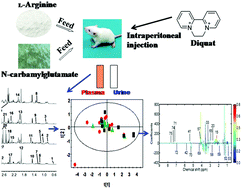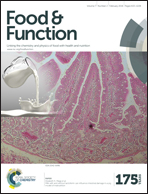Changes in the metabolome of rats after exposure to arginine and N-carbamylglutamate in combination with diquat, a compound that causes oxidative stress, assessed by 1H NMR spectroscopy†
Abstract
Numerous factors can induce oxidative stress in animal production and lead to growth retardation, disease, and even death. Arginine and N-carbamylglutamate can alleviate the effects of oxidative stress. However, the systematic changes in metabolic biochemistry linked to oxidative stress and arginine and N-carbamylglutamate treatment remain largely unknown. This study aims to examine the effects of arginine and N-carbamylglutamate on rat metabolism under oxidative stress. Thirty rats were randomly divided into three dietary groups (n = 10 each). The rats were fed a basal diet supplemented with 0 (control), 1% arginine, or 0.1% N-carbamylglutamate for 30 days. On day 28, the rats in each treatment were intraperitoneally injected with diquat at 12 mg per kg body weight or sterile solution. Urine and plasma samples were analyzed by metabolomics. Compared with the diquat group, the arginine + diquat group had significantly lower levels of acetamide, alanine, lysine, pyruvate, tyrosine, α-glucose, and β-glucose in plasma; N-carbamylglutamate + diquat had higher levels of 3-hydroxybutyrate, 3-methylhistidine, acetone, allantoin, asparagine, citrate, phenylalanine, trimethylamine-N-oxide, and tyrosine, and lower levels of low density lipoprotein, lipid, lysine, threonine, unsaturated lipid, urea, and very low density lipoprotein (P < 0.05) in plasma. Compared with the diquat group, the arginine + diquat group had significantly higher levels of citrate, creatinine, homogentisate, and α-ketoglutarate while lower levels of acetamide, citrulline, ethanol, glycine, isobutyrate, lactate, malonate, methymalonate, N-acetylglutamate, N-methylnicotinamide, propionate, and β-glucose (P < 0.05) in urine. Compared with the diquat group, the N-carbamylglutamate + diquat group had significantly higher levels of allantoin, citrate, homogentisate, phenylacetylglycine, α-ketoglutarate, and β-glucose while lower levels of acetamide, acetate, acetone, benzoate, citrulline, ethanol, hippurate, lactate, N-acetylglutamate, nicotinamide, ornithine, and trigonelline (P < 0.05) in urine. Overall, these results suggest that arginine and N-carbamylglutamate can alter the metabolome associated with energy metabolism, amino acid metabolism, and gut microbiota metabolism under oxidative stress.


 Please wait while we load your content...
Please wait while we load your content...